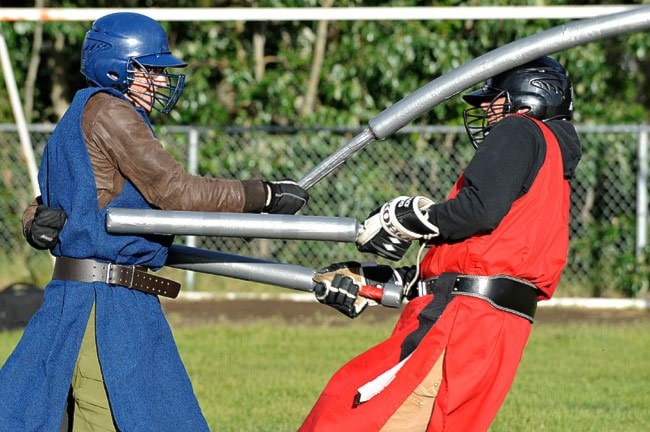It’s not really stripping, but it kind of is.
Burlesque dancing - known for its theatrical, saucy performances and glittering costumes - has come full circle.
After being banned in the 1930s for descending into full-blown striptease, the vaudeville-style routine has resurfaced.
But more than 100 years after burlesque started appearing in British and American theatres, the same debate over sexual appropriateness still rages.
In the 1800s it was an issue of morality. Decent women didn’t dance on burlesque stages that catered to low-brow audiences.
In 2010, women are able to express their sexuality more freely. But there’s still fear they’ll be criticized for objectifying their bodies on stage.
The second wave of feminism “desexualized” women, says Mary Shearman who is in Whitehorse Monday to talk about the rise of neo-burlesque over the last 20 years.
“Feminists who take issue with burlesque are kind of stuck between a rock and a hard place,” said Shearman, who is a PhD candidate in the women’s studies program at Simon Fraser University.
“Feminists believe women can be and do whatever they want but still find it difficult to accept and justify (burlesque) when it looks exactly what they’re fighting against.”
Shearman herself struggled with that issue.
“When I first discovered neo-burlesque I was also getting into feminism at the same time,” she said.
“(It was hard because) I would see strong woman on stage embracing, what, as a feminist I wasn’t supposed to like - like high heels, feathers and make-up.”
Shearman thinks that burlesque can be liberating, as many women who take up the art form claim.
“I don’t think it’s unreasonable to see the sexualized female body as empowering,” she said.
But she also isn’t naive about what it isn’t, she said.
Often burlesque dancers and audience-members make a clear distinction between burlesque and stripping. Burlesque is often considered a “classier” form of performance.
“I think that distinction is a silly social construct,” said Shearman.
“I’ve seen really hilarious (vaudeville-style) performances at a typical night at the strip club.
“That distinction becomes tied to the venue where girls are performing. In the end it creates a hierarchy which essentially falls back on the idea of class.”
Shearman’s PhD focuses on the Penthouse Nightclub in Vancouver, the city’s longest-running exotic dance club.
She also works with FIRST, an organization that advocates for the decriminalization of prostitution in Canada.
“The big thing for me and what I don’t understand is why all sex-work and strip-work is inherently considered evil,” she said.
“If it works for some people it can’t all be wrong.”
The issue of burlesque has particular relevance in the Yukon where dancers used to grace Gold Rush stages and have recently reappeared under the guise of Varietease, a local burlesque troupe.
The art behind burlesque is the mystery in it, said Fiona Solon, the brains behind Varietease.
“It still has that taboo side even if you’re not showing full frontal,” she said.
When Solon started up Varietease a few years ago back she wanted to focus on the theatrical side of burlesque.
“We do more than just burlesque skits - we have an emcee, comedy skits, and a live band - I haven’t seen that anywhere else.”
Garnette Davidson-Marshall worked as a dresser on the second show of Varietease.
As someone who grew up as a tomboy, she credits burlesque and belly-dancing for bringing out her femininity.
“I saw the women in that show as incredibly powerful, and strong,” said Davidson-Marshall.
“The show wasn’t about sex or an excuse to take off their clothes. The show is sensual, playful, and full of personality.”
That experience encouraged her to perform in the most recent Varietease show last fall.
After the show she heard some younger boys who played up the fact that she was partially naked on stage.
“They were saying some really immature stuff, but I talked to them about it,” she said.
“No matter what you put out there people will interpret what you do differently.”
Telling other women that they can’t dance because it could objectify them doesn’t make sense, she said.
“To say women can’t be sexual only encourages rebellion and a wrong idea about women’s sexuality.”
Solon didn’t hear any criticism from people when she first ran Varietease two years ago.
But she doesn’t doubt that it was out there.
In the end though, she realizes that dancers can’t take themselves too seriously.
“This performance art is done for fun, it’s not to pay the bills.”
And for Shearman, that’s the only thing that separates burlesque of today from the burlesque of 150 years ago.
Shearman speaks about neo-burlesque Monday at 7 p.m. at the Whitehorse Public Library. The lecture is sponsored by the Women’s Directorate and the Victoria Faulkner Women’s Centre.
Contact Vivian Belik at
vivianb@yukon-news.com
